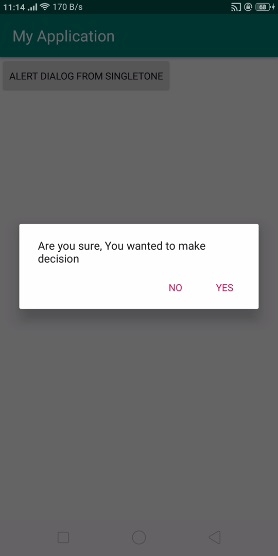
 Data Structure
Data Structure Networking
Networking RDBMS
RDBMS Operating System
Operating System Java
Java MS Excel
MS Excel iOS
iOS HTML
HTML CSS
CSS Android
Android Python
Python C Programming
C Programming C++
C++ C#
C# MongoDB
MongoDB MySQL
MySQL Javascript
Javascript PHP
PHP
- Selected Reading
- UPSC IAS Exams Notes
- Developer's Best Practices
- Questions and Answers
- Effective Resume Writing
- HR Interview Questions
- Computer Glossary
- Who is Who
How to use Singleton Alert Dialog in android?
Before getting into example, we should know what singleton design pattern is. A singleton is a design pattern that restricts the instantiation of a class to only one instance. Notable uses include controlling concurrency, and creating a central point of access for an application to access its data store.
This example demonstrates How to use Singleton Alert Dialog in android
Step 1 − Create a new project in Android Studio, go to File ⇒ New Project and fill all required details to create a new project.
Step 2 − Add the following code to res/layout/activity_main.xml.
<?xml version = "1.0" encoding = "utf-8"?> <LinearLayout xmlns:android = "http://schemas.android.com/apk/res/android" xmlns:tools = "http://schemas.android.com/tools" android:layout_width = "match_parent" android:layout_height = "match_parent" tools:context = ".MainActivity" android:orientation = "vertical"> <Button android:id = "@+id/show" android:text = "Alert Dialog from singleTone" android:layout_width = "wrap_content" android:layout_height = "wrap_content" /> </LinearLayout>
In the above code, we have taken a button. When user click on show button, it will show alert Dialog from singleton class.
Step 3 − Add the following code to src/MainActivity.java
package com.example.andy.myapplication;
import android.os.Bundle;
import android.support.v7.app.AppCompatActivity;
import android.view.View;
import android.widget.Button;
public class MainActivity extends AppCompatActivity {
Button show;
singleTonExample singletonexample;
@Override
protected void onCreate(Bundle savedInstanceState) {
super.onCreate(savedInstanceState);
setContentView(R.layout.activity_main);
show = findViewById(R.id.show);
singletonexample = singleTonExample.getInstance();
singletonexample.init(getApplicationContext());
show.setOnClickListener(new View.OnClickListener() {
@Override
public void onClick(View v) {
singletonexample.AlertDialog(MainActivity.this);
}
});
}
}
In the above code, we have used singleTonExample as singleton class so create a call as singleTonExample.java and add the following code-
package com.example.andy.myapplication;
import android.app.AlertDialog;
import android.content.Context;
import android.content.DialogInterface;
import android.speech.tts.TextToSpeech;
import android.widget.Toast;
public class singleTonExample {
static TextToSpeech t1;
private static singleTonExample ourInstance = new singleTonExample();
private Context appContext;
private singleTonExample() { }
public static Context get() {
return getInstance().getContext();
}
public static synchronized singleTonExample getInstance() {
return ourInstance;
}
public void init(Context context) {
if (appContext = = null) {
this.appContext = context;
}
}
private Context getContext() {
return appContext;
}
public void AlertDialog(final MainActivity mainActivity) {
AlertDialog.Builder alertDialogBuilder = new AlertDialog.Builder(mainActivity);
alertDialogBuilder.setMessage("Are you sure, You wanted to make decision");
alertDialogBuilder.setPositiveButton("yes",
new DialogInterface.OnClickListener() {
@Override
public void onClick(DialogInterface arg0, int arg1) {
Toast.makeText(mainActivity, "You clicked yes button", Toast.LENGTH_LONG).show();
}
});
alertDialogBuilder.setNegativeButton("No", new DialogInterface.OnClickListener() {
@Override
public void onClick(DialogInterface dialog, int which) {
mainActivity.finish();
}
});
AlertDialog alertDialog = alertDialogBuilder.create();
alertDialog.show();
}
}
Let's try to run your application. I assume you have connected your actual Android Mobile device with your computer. To run the app from android studio, open one of your project's activity files and click Run ![]() icon from the toolbar. Select your mobile device as an option and then check your mobile device which will display your default screen –
icon from the toolbar. Select your mobile device as an option and then check your mobile device which will display your default screen –

Now click on above button, it will show alert dialog from singleton class as shown below -.

Click here to download the project code

